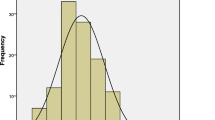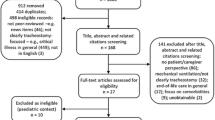Abstract
Upper Respiratory Tract Infections (URTI) are very common in children having no effective pharmacological treatment. This study aimed to compare the effect of caregivers’ health education regarding children’s respiratory infections and the effect of a rhinopharyngeal clearance protocol in children with URTI. A factorial trial was conducted in 138 children up to 3 years, attending day-care centres. Children were distributed into four groups: control group (CG) (n = 38); education group (EG) (n = 34); intervention group (IG) (n = 35); and education and intervention group (E + IG) (n = 31). A Diary of Records was kept by caregivers during 1 month. There were significant differences between groups concerning: Lower Respiratory Tract Infections (CG = 29.4%; EG = 10.7%; IG = 3.8%; E + IG = 0.0%; p = 0.014); acute otitis media (CG = 32.4%; EG = 7.1%; IG = 11.5%; E + IG = 7.7%; p = 0.014); medical consultations (CG = 70.6%; EG = 42.9%; IG = 38.5%; E + IG = 30.8%; p = 0.021); antibiotics (CG = 44.1%; EG = 7.1%; IG = 23.1%; E + IG = 15.4%; p = 0.006); days missed from day-care (CG = 55 days; EG = 22 days; IG = 14 days; E + IG = 6 days; p = 0.020); days missed from employment (CG = 31 days; EG = 20 days; IG = 5 days; E + IG = 1 day; p = 0.021); and nasal clearance techniques (CG = 41.4%; EG = 78.6%; IG = 57.7%; E + IG = 84.6%; p = 0.011).
Conclusion: This study showed that the most positive impact on children’s health outcomes occurred when combining health education of caregivers, regarding children’s respiratory infections, with a rhinopharyngeal clearance protocol in children with URTI.
What is Known: • Upper Respiratory Tract Infections are very common in children but still do not have an effective pharmacological treatment. • This generates a great burden of disease for the child and families, increasing the use of antibiotics. |
What is New: • This study is the first one that aims to analyze the effects of caregivers’ health education in comparison to non-pharmacological intervention in acute respiratory infections in children. • It shows a positive impact on children’s health outcomes, empowering caregivers regarding their child’s health and reducing the burden of disease, medical consultations and the use of antibiotics. |


Similar content being viewed by others
Abbreviations
- AOM:
-
Acute otitis media
- CG:
-
Control group
- DRR:
-
Désobstruction Rhinopharyngée Rétrograde
- E + IG:
-
Education and intervention group
- ED:
-
Education group
- HES:
-
Health Education Session
- IG:
-
Intervention group
- LRTI:
-
Lower Respiratory Tract Infections
- PRSS:
-
Paediatric Respiratory Severity Score
- URTI:
-
Upper Respiratory Tract Infections
References
Alexandrino AS, Santos R, Melo C, Bastos JM (2016) Risk factors for respiratory infections among children attending day care centres. Fam Pract 33:161–166
Alexandrino AS, Santos R, Melo C, Bastos JM (2016) Designing and evaluating a health education session on respiratory infections among children under 3 years old attending day-care centres in Porto, Portugal: a randomised trial. Manuscript submitted for publication
AMFdS A, Santos RIGV, MCDAd M, Bastos JAM, Postiaux G (2017) Subjective and objective parameters in paediatric respiratory conditions: cultural adaptation to Portuguese population. Fisioterapia em Movimento 30:49–58
Andermann A, Pang T, Newton JN, Davis A, Panisset U (2016) Evidence for health I: producing evidence for improving health and reducing inequities. Health Research Policy and Systems 14:1
Andrews T, Thompson M, Buckley DI, Heneghan C, Deyo R, Redmond N, Lucas PJ, Blair PS, Hay AD (2012) Interventions to influence consulting and antibiotic use for acute respiratory tract infections in children: a systematic review and meta-analysis. PLoS One 7:e30334
Azor-Martínez E, Gonzalez-Jimenez Y, Seijas-Vazquez ML, Cobos-Carrascosa E, Santisteban-Martínez J, Martínez-López JM, Jimenez-Noguera E, del Mar G-RM, Garrido-Fernández P, Strizzi JM (2014) The impact of common infections on school absenteeism during an academic year. Am J Infect Control 42:632–637
Baraldi E, Lanari M, Manzoni P, Rossi GA, Vandini S, Rimini A, Romagnoli C, Colonna P, Biondi A, Biban P (2014) Inter-society consensus document on treatment and prevention of bronchiolitis in newborns and infants. Ital J Pediatr 40:1–13
Chirico G, Quartarone G, Mallefet P (2014) Nasal congestion in infants and children: a literature review on efficacy and safety of non-pharmacological treatments. Minerva Pediatr 66:549–557
Francis NA, Butler CC, Hood K, Simpson S, Wood F, Nuttall J (2009) Effect of using an interactive booklet about childhood respiratory tract infections in primary care consultations on reconsulting and antibiotic prescribing: a cluster randomised controlled trial. BMJ:339
Gomes ÉL, Postiaux G, Medeiros DR, Monteiro KK, Sampaio LM, Costa D (2012) Chest physical therapy is effective in reducing the clinical score in bronchiolitis: randomized controlled trial. Braz J Phys Ther 16:241–247
de Hoog ML, Venekamp RP, van der Ent CK, Schilder A, Sanders EA, Damoiseaux RA, Bogaert D, Uiterwaal CS, Smit HA, Bruijning-Verhagen P (2014) Impact of early daycare on healthcare resource use related to upper respiratory tract infections during childhood: prospective WHISTLER cohort study. BMC Med 12:107
Ingram J, Cabral C, Hay AD, Lucas PJ, Horwood J (2013) Parents’ information needs, self-efficacy and influences on consulting for childhood respiratory tract infections: a qualitative study. BMC Fam Pract 14:106
Kusel MM, De Klerk N, Holt PG, Landau LI, Sly PD (2007) Occurrence and management of acute respiratory illnesses in early childhood. J Paediatr Child Health 43:139–146
von Linstow ML, Holst KK, Larsen K, Koch A, Andersen PK, Høgh B (2008) Acute respiratory symptoms and general illness during the first year of life: a population-based birth cohort study. Pediatr Pulmonol 43:584–593
Marchisio P, Picca M, Torretta S, Baggi E, Pasinato A, Bianchini S, Nazzari E, Esposito S, Principi N (2014) Nasal saline irrigation in preschool children: a survey of attitudes and prescribing habits of primary care pediatricians working in northern Italy. Ital J Pediatr 40:1–8
Merzel C, D'afflitti J (2003) Reconsidering community-based health promotion: promise, performance, and potential. Am J Public Health 93:557–574
Moody SA, Alper CM, Doyle WJ (1998) Daily tympanometry in children during the cold season: association of otitis media with upper respiratory tract infections. Int J Pediatr Otorhinolaryngol 45:143–150
NICE CfCPa (2008) Respiratory tract infections—antibiotic prescribing: prescribing of antibiotics for self-limiting respiratory tract infections in adults and children in primary care
Nokso-Koivisto J, Hovi T, Pitkäranta A (2006) Viral upper respiratory tract infections in young children with emphasis on acute otitis media. Int J Pediatr Otorhinolaryngol 70:1333–1342
Pönkä A, Poussa T, Laosmaa M (2004) The effect of enhanced hygiene practices on absences due to infectious diseases among children in day care centers in Helsinki. Infection 32:2–7
Postiaux G (2001) Quelles sont les techniques de désencombrement bronchique et des voies aériennes supérieures adaptées chez le nourrisson? Arch Pediatr 8:117–125
Postiaux G, Souza Pinto V, Vieira DR, Carvalho CM (2004) Fisioterapia respiratória pediátrica: o tratamento guiado por ausculta pulmonar. Artmed Editora, Porto Alegre
Postiaux G, Louis J, Labasse HC, Gerroldt J, Kotik A-C, Lemuhot A, Patte C (2011) Evaluation of an alternative chest physiotherapy method in infants with respiratory syncytial virus bronchiolitis. Respir Care 56:989–994
Rabago D, Zgierska A (2009) Saline nasal irrigation for upper respiratory conditions. Am Fam Physician 80:1117–1119
Ralston SL, Lieberthal AS, Meissner HC, Alverson BK, Baley JE, Gadomski AM, Johnson DW, Light MJ, Maraqa NF, Mendonca EA (2014) Clinical practice guideline: the diagnosis, management, and prevention of bronchiolitis. Pediatrics 134:e1474–e1502
Revai K, Patel JA, Grady JJ, Chonmaitree T (2008) Tympanometric findings in young children during upper respiratory tract infections with and without acute otitis media. Pediatr Infect Dis J 27:292–295
Shaikh N, Wald ER (2014) Decongestants, antihistamines and nasal irrigation for acute sinusitis in children. Cochrane Database Syst Rev 10
Simasek M, Blandino DA (2007) Treatment of the common cold. Am Fam Physician 75:515–520
Smith BJ, Tang KC, Nutbeam D (2006) WHO health promotion glossary: new terms. Health Promot Int 21:340–345
Stockwell MS, Catallozzi M, Larson E, Rodriguez C, Subramony A, Martinez RA, Martinez E, Barrett A, Meyer D (2014) Effect of a URI-related educational intervention in early head start on ED visits. Pediatrics 133:e1233–e1240
Thompson M, Vodicka TA, Blair PS, Buckley DI, Heneghan C, Hay AD (2013) Duration of symptoms of respiratory tract infections in children: systematic review. BMJ 347:f7027
Tomooka LT, Murphy C, Davidson TM (2000) Clinical study and literature review of nasal irrigation. Laryngoscope 110:1189–1193
Venekamp RP, Sanders S, Glasziou PP, Del Mar CB, Rovers MM (2013) Antibiotics for acute otitis media in children. The Cochrane Library
Wang Y-H, Yang C-P, Ku M-S, Sun H-L, Lue K-H (2009) Efficacy of nasal irrigation in the treatment of acute sinusitis in children. Int J Pediatr Otorhinolaryngol 73:1696–1701
Winther B, Hayden FG, Arruda E, Dutkowski R, Ward P, Hendley JO (2002) Viral respiratory infection in schoolchildren: effects on middle ear pressure. Pediatrics 109:826–832
Wormald PJ, Cain T, Oates L, Hawke L, Wong I (2004) A comparative study of three methods of nasal irrigation. Laryngoscope 114:2224–2227
Acknowledgements
The authors would like to thank all the caregivers and educators from the day-care centres who accepted to participate in this study. A special thanks to Veronica Parreiro, Inês Azevedo and Daniel Costa for their help in the early stages of this project.
Funding
The authors declare that they received no funding.
Author information
Authors and Affiliations
Contributions
Alexandrino, AS was responsible for the conception and the design of the study, acquisition of data, analysis and interpretation of data and drafting the article; Santos, R took part in the design of the study, acquisition of data, analysis and interpretation of data and revised the paper; Melo, C took part in the design of the study, reviewed the findings and revised the paper; Bastos, JM assured the medical supervision of the study and revised the paper; Postiaux, G developed the intervention procedures and revised the paper. All authors read and approved the final manuscript.
Corresponding author
Ethics declarations
Conflict of interests
The authors declare that they have no conflict of interest.
Ethical approval and consent to participate
All procedures performed in this study were in accordance with the ethical standards of the Ethics Committee of the School of Allied Health Technologies, Polytechnic Institute of Porto (CE_1744/2014) and with the 1964 Helsinki Declaration and its later amendments or comparable ethical standards. Informed consent was obtained from all individual participants included in this study.
This study is registered at ClinicalTrials.gov with the identifier: NCT02588963.
Availability of data and material
The dataset supporting the conclusions of this article is available from the authors.
Additional information
Communicated by Nicole Ritz
Rights and permissions
About this article
Cite this article
Alexandrino, A.S., Santos, R., Melo, C. et al. Caregivers’ education vs rhinopharyngeal clearance in children with upper respiratory infections: impact on children’s health outcomes. Eur J Pediatr 176, 1375–1383 (2017). https://doi.org/10.1007/s00431-017-3003-z
Received:
Revised:
Accepted:
Published:
Issue Date:
DOI: https://doi.org/10.1007/s00431-017-3003-z




